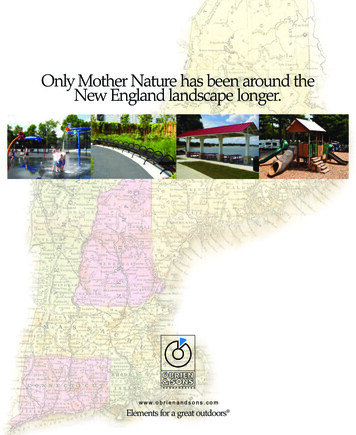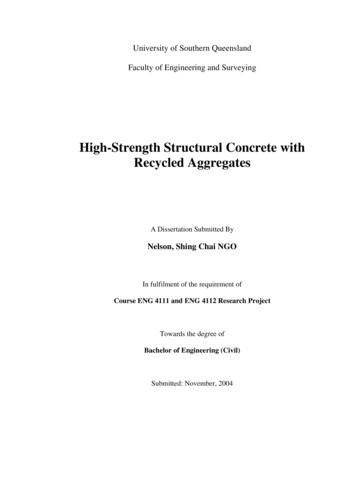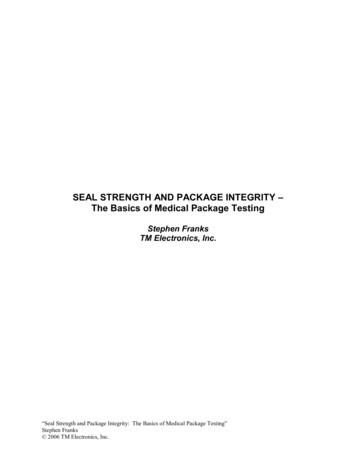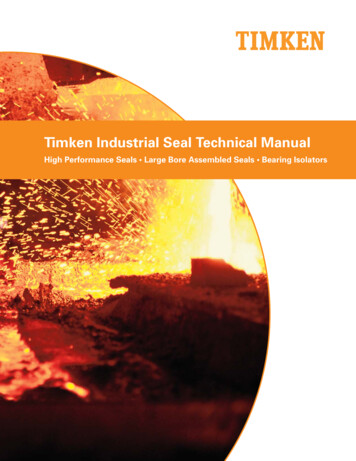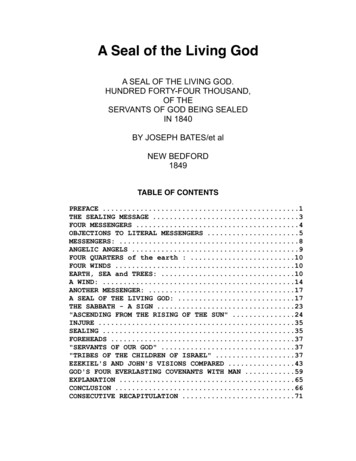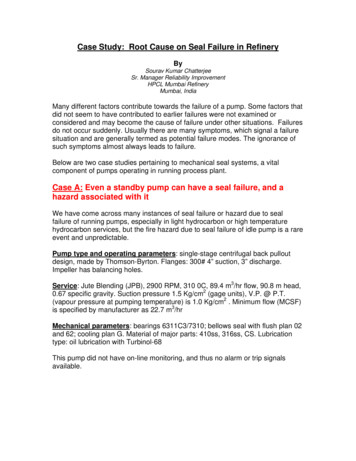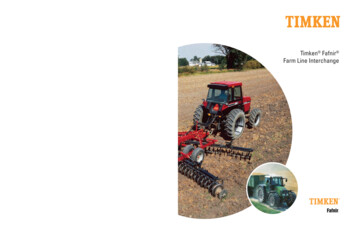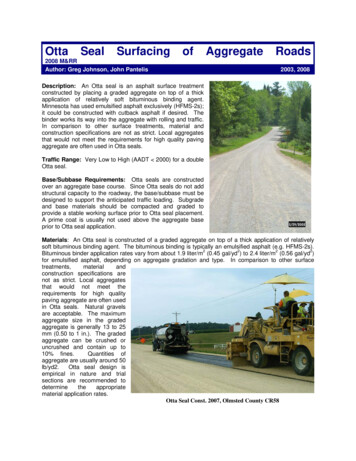
Transcription
OttaSealSurfacingof2008 M&RRAuthor: Greg Johnson, John PantelisAggregateRoads2003, 2008Description: An Otta seal is an asphalt surface treatmentconstructed by placing a graded aggregate on top of a thickapplication of relatively soft bituminous binding agent.Minnesota has used emulsified asphalt exclusively (HFMS-2s);it could be constructed with cutback asphalt if desired. Thebinder works its way into the aggregate with rolling and traffic.In comparison to other surface treatments, material andconstruction specifications are not as strict. Local aggregatesthat would not meet the requirements for high quality pavingaggregate are often used in Otta seals.Traffic Range: Very Low to High (AADT 2000) for a doubleOtta seal.Base/Subbase Requirements: Otta seals are constructedover an aggregate base course. Since Otta seals do not addstructural capacity to the roadway, the base/subbase must bedesigned to support the anticipated traffic loading. Subgradeand base materials should be compacted and graded toprovide a stable working surface prior to Otta seal placement.A prime coat is usually not used above the aggregate baseprior to Otta seal application.Materials: An Otta seal is constructed of a graded aggregate on top of a thick application of relativelysoft bituminous binding agent. The bituminous binding is typically an emulsified asphalt (e.g. HFMS-2s).Bituminous binder application rates vary from about 1.9 liter/m2 (0.45 gal/yd2) to 2.4 liter/m2 (0.56 gal/yd2)for emulsified asphalt, depending on aggregate gradation and type. In comparison to other surfacetreatments,materialandconstruction specifications arenot as strict. Local aggregatesthat would not meet therequirements for high qualitypaving aggregate are often usedin Otta seals. Natural gravelsare acceptable. The maximumaggregate size in the gradedaggregate is generally 13 to 25mm (0.50 to 1 in.). The gradedaggregate can be crushed oruncrushed and contain up to10% fines.Quantities ofaggregate are usually around 50lb/yd2.Otta seal design isempirical in nature and trialsections are recommended todeterminetheappropriatematerial application rates.Otta Seal Const. 2007, Olmsted County CR58
Equipment: Equipment required for Otta seal construction includes: asphalt distributor, chip spreader,pneumatic-tired roller, and mechanical broom.Placement Process: The bituminous binding agent is sprayed onto the prepared working surface by thedistributor; then, the graded aggregate is spread onto the surface using an aggregate spreader. After theaggregate is placed, the surface is rolled with a pneumatic-tired roller to embed, realign the aggregatechips in the binder, and begin drawing the binder through the aggregate to the surface. Due to the finesin the aggregate, two or three days of compaction, either by rollers or traffic, is required for the binder tocoat all the aggregate particles. During the first few weeks, aggregates dislodged from the surfacing bytraffic should be swept back into the wheelpaths. After about three weeks, the surface should be sweptby a mechanical broom to remove all loose aggregate from the surfacing. The second layer of a doubleseal is constructed in a similar manner two to three months after the first layer is constructed. Withattention to details a second application can be applied 1 day after the first application. However, two tothree months is recommended.Lane Closure Requirements: The roadway lane being constructed is closed during construction, soadequate traffic control is needed. The Otta seal surface can be opened to traffic as soon as it isconstructed.Reliability and Performance History: Otta sealswere developed in Norway in the 1960s. They havebeen used frequently in Norway, Sweden, Iceland,and Botswana, and to a less extent in several othercountries. Otta seal performance has been good incountries that are familiar with this type of surfacing.Otta seal design is empirical in nature and trialsections are often construction to determine theproper material application rates.Life Expectancy:Life expectancy variesdepending on construction materials used,environmental conditions, and traffic volumes.Reported serviceable lives for double Otta sealsrange from 8 to 15 years.Ride Quality: Otta seals can provide minor improvements toride quality, but will not mitigate significant defects (rutting,depressions, etc.) in the application surface. On a properprepared application surface, a good ride quality can beachieved after construction. Ride quality deteriorates over theserviceable life.Ability to Recycle/Reuse: Otta seals can be pulverized andreused as an unbound or stabilized material.Appearance: Immediately after placement, the Otta seal’sappearance is similar to a gravel road and is influenced by the aggregate color. With time and traffic, theblack bituminous binding agent works its way up through the aggregate, creating a surface appearancesimilar to cold mix asphalt concrete.Supply Install Price (in 2003 dollars): 24,000 to 34,000/mile (28 foot width)EXAMPLE PROJECTSCass County Roads 25 & 171 and many other township roads, Cass County, MN; MN Highway 74, northof Whitewater State Park, Elba MN; Fillmore County Road 20, Lanesboro, MN.Other Comments: Otta seals have been used as an impermeable surfacing for moisture-susceptiblegravel roads with low bearing capacity (i.e. roads during spring thaw period). The Otta seal shields the
base material from moisture infiltration and is flexible enough to withstand the relatively large deflectionsassociated with low bearing capacity roads without exhibiting significant distress. If there is permanentdeformation of the base, the Otta will not knead back together.Because Otta seals can provide a high-quality road surfacing, there is a tendency for higher road usageand speeding that may be beyond the geometrics of the existing roadway.Otta Seal – 2008 Review John Pantelis, Minnesota Department ofTransportationDescription: A field review of Otta Seal Projects was conducted to evaluate the performance of projectscompleted since 2001. These sections had been in place for some time with little or no review of aging orrepairs.Review: CR168 was in good shape. Itappeared to have 1-in. aggregate. Typical50 foot thermal cracks where noted,surface had no fine aggregate, and snowpacking was seen in shaded areas.Otta Seal constructed 2003, Cass County CR168.Review: Unmarked Road NE of CR168 was in good / fair shape. Potholes on the centerline wererepaired and new were present, some wheel tracking and delamination present. Intersections intohousing developments were upgraded with HMA. Otta Seal intersections were somewhat rough.Otta Seal constructed 2003, NE of CassCounty CR168.
Review: CR171 was in good condition andwas treated with a chip seal. The chip sealgave the Otta Seal a clean finish.Longitudinal cracks where evident alongswampy areas.Otta Seal constructed 2001, CassCounty CR171.Review: CR25 was in good and was also treated with a chip seal. CR25 has a large dairy farm whichfeatures truck traffic with sizable loads. Road & chip look ingood shape. Northern intersection repaired / replaced withHMA to correct previous pushing problem.Otta Seal constructed 2001, CassCounty CR25 – Dairy Farm.Cass Co. Birch Lake Sections: Due to the low traffic & light use over the winter months, the northernsections were not plowed well enough to review. All had heavy packed snow, which aids in plowing inyour typical aggregate road structures. Two areas were listed to be either Bad or So-So conditions, butviewed. Terrain in these areas varied. Some areas were Y intersections with other roads, others wereswampy, hilly, and some lacked proper drainage for good performance.Review: 116 & 117 were in good shape and were also treated with a chip seal. Road & chip looked ingood shape. Intersections with turning or crossing farm equipment looked in good shape.
Otta Seal Const. 2002, Cass CountyCR25 – Dairy FarmSELECT RESOURCESJohnson, Greg (2003). “Minnesota’s Experience with Thin Bituminous Treatments for Low-VolumeRoads,” Transportation Research Record 1819, TRB, National Research Council, Washington, D.C.,pp. 333-337.Norwegian Public Roads Administration (1999). “A Guide to the Use of Otta Seals,” PIARC XXIst WorldRoad Congress, Kuala Lumpur, Malaysia.Thurmann-Moe, T., and Ruistuen, H. (1983). “Graded Gravel Seal (Otta Surfacing),” TransportationResearch Record 898, TRB, National Research Council, Washington, D.C., 333-335.NEED MORE INFORMATION ON OTTA SEAL SURFACING OR THE MINNESOTA ROAD RESEARCH PROJECT(MN/ROAD)?Contact: Minnesota Department of TransportationOFFICE OF MATERIALS & ROAD RESEARCH1400 GERVAIS AVE. MS 645MAPLEWOOD, MN 55109ROGER OLSON(651)366-5517GREG JOHNSON(651)366-5497ED JOHNSON(651)366-5465Mn/ROADOffice of Materials1400 Gervais AvenueMaplewood, MN 55109http://mnroad.dot.state.mn.us
Otta Seal Surfacing of Aggregate Roads 2008 M&RR Author: Greg Johnson, John Pantelis 2003, 2008 Description: An Otta seal is an asphalt surface treatment constructed by placing a graded aggregate on top of a thick . binder works its way into the aggregate with rolling and traffic. In

